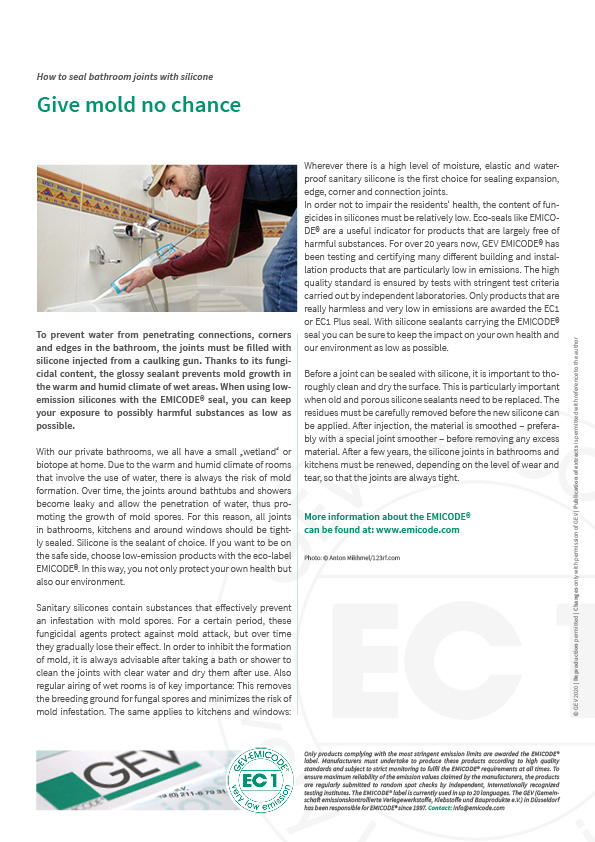Give mold no chance
How to seal bathroom joints with silicone
With our private bathrooms, we all have a small “wetland” or biotope at home. Due to the warm and humid climate of rooms that involve the use of water, there is always the risk of mold formation. Over time, the joints around bathtubs and showers become leaky and allow the penetration of water, thus promoting the growth of mold spores. For this reason, all joints in bathrooms, kitchens and around windows should be tightly sealed. Silicone is the sealant of choice. If you want to be on the safe side, choose low-emission products with the eco-label EMICODE®. In this way, you not only protect your own health but also our environment.
Sanitary silicones contain substances that effectively prevent an infestation with mold spores. For a certain period, these fungicidal agents protect against mold attack, but over time they gradually lose their effect. In order to inhibit the formation of mold, it is always advisable after taking a bath or shower to clean the joints with clear water and dry them after use. Also regular airing of wet rooms is of key importance: This removes the breeding ground for fungal spores and minimizes the risk of mold infestation. The same applies to kitchens and windows: Wherever there is a high level of moisture, elastic and waterproof sanitary silicone is the first choice for sealing expansion, edge, corner and connection joints.
In order not to impair the residents’ health, the content of fungicides in silicones must be relatively low. Eco-seals like EMICODE® are a useful indicator for products that are largely free of harmful substances. For over 20 years now, GEV EMICODE® has been testing and certifying many different building and installation products that are particularly low in emissions. The high quality standard is ensured by tests with stringent test criteria carried out by independent laboratories. Only products that are really harmless and very low in emissions are awarded the EC1 or EC1 Plus seal. With silicone sealants carrying the EMICODE® seal you can be sure to keep the impact on your own health and our environment as low as possible.
Before a joint can be sealed with silicone, it is important to thoroughly clean and dry the surface. This is particularly important when old and porous silicone sealants need to be replaced. The residues must be carefully removed before the new silicone can be applied. After injection, the material is smoothed – preferably with a special joint smoother – before removing any excess material. After a few years, the silicone joints in bathrooms and kitchens must be renewed, depending on the level of wear and tear, so that the joints are always tight.

Photo: ©Anton Mikhmel/123rf.com
To prevent water from penetrating connections, corners and edges in the bathroom, the joints must be filled with silicone injected from a caulking gun. Thanks to its fungicidal content, the glossy sealant prevents mold growth in the warm and humid climate of wet areas. When using low-emission silicones with the EMICODE® seal, you can keep your exposure to possibly harmful substances as low as possible.

Do You Have Questions?
If you have questions about specific topics or if you would like to contact us for any other reason, feel free to contact us by phone, fax or e‑mail.
Phone: +49 211 / 67931–20
Fax: +49 211 / 67931–33
info@emicode.com
Share article on Social Media:
